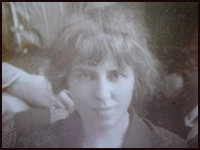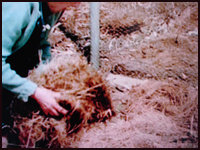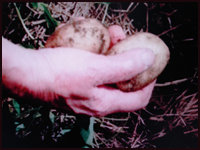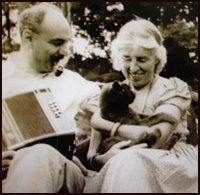





Margaret Roach was "Martha Stewart Living" magazine's garden editor and editorial director for 15 years. After "retiring" in 2008, Margaret started producing her own gardening media content and it was through her website that I first learned of Ruth Stout.
Born in Kansas, Ruth Stout (1884 -1980) lived in Topeka until she was 18, then moved to New York and lived there until she was 45. "Never once wishing that I could have a garden," Ruth said in a 1976 video. After being married for only a few months, Stout's husband asked Ruth if she would like to live in the country. "And without even knowing that I would, I said 'Oh yes!'" After purchasing their "quaint little cottage," Ruth said, "We hadn't been here more than ten minutes and I was out there looking at the lilac bush, apple trees and so on, immediately I got thrilled about gardening, knew nothing about it."
After 15 years of gardening "like everybody else" Ruth had her "a-ha!" moment: "One morning in early April I went out to the garden, couldn't do anything, just went out to shed a tear because I couldn't begin to plant, the plowman hadn't come. I walked over to the asparagus and I said, 'We don't have to plow for you, why do we have to plow for the other vegetables?' And the asparagus said, 'You don't, go ahead and plant.' If the asparagus had said that to anybody with any sense they wouldn't have paid any attention, they would have said, 'Well you're a perennial.' Because asparagus like a tree or like a rose bush, just comes up every year. But anyway, since I wasn't very smart, I just ran and got my seeds and planted them. And that's been going on for 35 years."

Gardening to Ruth Stout meant using mulch, and lots of it. Her "method" involved a type of layering system much like the lasagna system of gardening: put down a layer of old newspapers or cardboard, cover that with some type of organic mulch, and add another layer of newspaper or cardboard, and more mulch. This is done until an 8-inch layer is built up, and then you plant directly into the "lasagna." Stout's method is based on layering with hay, or straw (according to Ruth, "bad" or moldy hay was okay to use), and other dead vegetation. Let it lay and decompose in the garden, add straw and/or hay, seeds are planted in the soil as normal, and afterwards, mulch is arranged strategically, but doesn't cover tiny seeds such as lettuce or carrots. Such small seeds as that cannot sprout through the layer of hay mulch, but large seeds of plants like squash and cucumber can grow through mulch so Ruth mulched over the large seeds.
After many years, Ruth Stout's pattern of layering and mulching with hay, and yes, she even used hay with weed seeds in it, added all the nutrients to the soil that her garden needed. She didn't need artificial fertilizers, everything was provided naturally by the decomposed hay, straw, and other plant matter. Sounds like the perfect gardening system "for the aging, the busy and the indolent" doesn't it?

In the foreword to Ruth Stout's book, "Gardening Without Work: For the Aging, the Busy and the Indolent" Charles Elliott writes: "The idea is this: permanent mulch. Instead of digging up the earth, cultivating, weeding, watering - all the things most gardeners do as a matter of course - you simply spread a deep mulch of hay, leave it on year-round, pulling it back in a minimal way for planting." I don't know of anyone here in my neck of the woods that uses this method, but it's told that growing potatoes in straw is perfectly productive and so I set up an experiment to do just that this season. So far, we've harvested a few new potatoes, small ones, for potato salad, and the Stout Method appears to be working well.
In "Gardening Without Work" Stout writes: "In my first book I had only a sentence or two about growing potatoes without covering them with dirt, for at that time I had never tried it. I said that one should make a furrow, drop the potatoes in it, then cover them with hay. I have now found that the furrow is unnecessary." Before moving to Pennsylvania from Kentucky, I had much experience planting potatoes in nice neat rows or furrows, and made sure to keep the soil hilled up around the plants as they grew. If any part of the potato tuber is exposed to too much sun, it will turn green and at that point the potato is not edible and should be discarded. This is why it's very important to keep soil hilled up around the base of plants as they grow. And if you're using the Stout Method of growing your potatoes in mulch, be sure to use plenty of hay or straw.

Some would argue that Ruth Stout's mulching method doesn't work for their gardens, and that's quite possible, after all, most gardeners I know each have their own unique way of doing things. But mulching is something all gardeners have in common. Instead of hay, I use straw, but there's no mention of straw in the video or book. I used straw as mulch before hearing about the Stout Method and it's always worked well. But I've discovered that Canadian thistle will often find its way through the straw no matter how thick the mulch is.
Ruth Stout mentions "witch grass" in "Gardening Without Work" and says she covered the stuff with layers of cardboard and newspapers. "I have made a wide path all around my plot of thick layers of newspapers and magazines, covering them with cardboard from large cartons," she writes. So, along with hay mulch Ruth also used layers of newsprint and cardboard. She wrote a sobering statement about the never ending battle she had with witch grass (it's also known as Johnson grass in some regions): "I've roughly figured out that the very last of the witch grass and I will just about simultaneously give up the ghost."
"Gardening Without Work" is full of witty remarks, anecdotes, tips and tricks, and Ruth Stout writes in a voice that is entertaining and easy to understand. If you've ever wondered about using mulch year-round, Ruth Stout's book will give you food for thought. And her video is also very informative. The video is available at Garedenworks.cc in VHS or DVD format. It's going to be harder for you to find a copy of Ruth Stout's book "Gardening Without Work: For the Aging, the Busy and the Indolent," it took me a couple of weeks just to rent a copy from the local library.
I transcribed some of what Ruth Stout had to say about gardening from the DVD "Ruth Stout's Garden" and I'd like to end with a very poignant quote from Ruth speaking about her grandfather.
"I couldn't admire anybody anymore than I admired my grandfather. He always knew exactly the right thing to do and to say with everybody. I don't mean correct thing of course, I mean the helpful thing. My oldest brother had a dog that he was crazy about and the dog died. My two oldest brothers were out where I could see them from the window burying the dog. And the tears were rolling down my cheeks because I was sorry for my brother. And my grandfather came in the room and he saw what was going on and he said, ‘Oh come here Ruth I want to show you something.' He took me over to the other side of the room and he said, ‘Here's the rose bush that you planted yourself, and look, it has a flower on it, you can go out and pick a flower off of your own rose bush.' I started out and he put his arm around me and he said, ‘Thee was looking out of the wrong window dear.'"

"Ruth Stout's Garden" Copyright © 1976, written and directed by Arthur Mokin.
"Gardening Without Work for the Aging, the Busy and the Indolent" by Ruth Stout, Copyright © 1961
To purchase a DVD or VHS copy of "Ruth Stout's Garden" click here, or visit the following website: http://www.gardenworks.cc/2.html - Ruth Stout's Garden dvd/vhs www.gardenworks.cc
Mother Earth News article on Ruth Stout: http://www.motherearthnews.com/Organic-Gardening/2004-02-01/Ruth-Stouts-System.aspx
Copyright © www.100flowers.win Botanic Garden All Rights Reserved